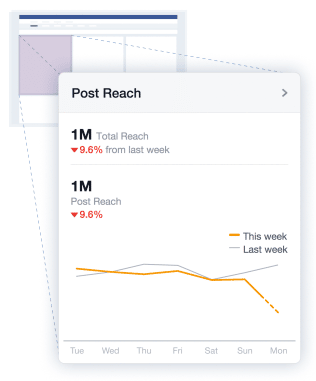Blog How to increase your Facebook organic reach in 6 easy steps

How to increase your Facebook organic reach in 6 easy steps
Times are tough, competition is rife, and budgets are being squeezed tighter than ever, so now is a great time to look at bringing it back to basics and focusing on organic content that doesn’t cost a dime.
But what are the best practices to make sure you’re making the most out of your organic content and getting as much reach as possible, with the best engagement?
We’ve pulled together six simple steps which will help take your content from barely there to top of the leaderboard in no time.
What is organic reach and why is it declining?
Organic reach is the number of people who see your content in their Facebook Feed through unpaid distribution i.e. without any ad spend. This type of content is free and doesn’t target any specific audience in the way that paid reach does, but Facebook’s algorithm does determine how and when your content is shown based on aspects like popularity, post frequency, the likelihood of engagement, and more.
Unfortunately, and unsurprisingly, organic reach has been on the decline for quite some time and it can be seriously frustrating to watch the numbers dwindle. The Ads Product Marketing team at Facebook have two reasons for the decline:
- More and more content is being created and shared everyday meaning there is more competition.
- To manage this competition, Meta has designed the Facebook Feed to show only content which it believes is most relevant to the user. This is down to a ranking system based on various factors which they believe offers a more engaging experience for the user.
But it’s not all doom and gloom when it comes to organic reach and there are still plenty of reasons to invest time into the platform.
Why use Facebook?
Think Facebook is old news? Think again. As of this year, Facebook has roughly 2.93 billion active users on its platform and continues to be the most used online social network worldwide. So it’s probably not too much of a stretch to think that your supporters make up a portion of that number and can be found scrolling their own Facebook Feeds, waiting for the right content to entertain them. GivePanel’s favorite saying is ‘meet supporters where they are’ but that doesn’t just mean by serving them ads. In order to succeed on Facebook it’s important nonprofits become a part of the community, and that’s where organic content comes in.
Organic content is also, believe it or not, a crucial part of your paid ads strategy. While organic posts on Facebook may not be the direct driving force behind donations, it does impact your brand reputation and trust with supporters. And without that, you can bet your bottom dollar that donation ads won’t land the same!
So, with more competition and a tightening of the purse strings, it’s never been more important to get your organic content in tip top shape.
6 steps to increasing your Facebook organic reach
1. Follow the rules
It might be obvious but it’s a biggie. When it comes to organic content on Facebook we highly recommend swatting up on the rules. Before you begin creating your content, have a read of Facebook’s community standards, paying close attention to the section on objectionable content so you know what is and isn’t allowed.
Break the rules? Meta will serve you a number of strikes and then you’re out – well, your page is unpublished with the chance to appeal but nobody wants to take it that far!
2. Lights, camera, action
It doesn’t take an Oscar-worthy director to create video content for social media. All you really need is a decent phone and some basic video editing tools like Canva (Canva fans assemble). In fact, recent trends have shown a shift to videos with a more authentic, less polished style, making it easier for even the most reluctant novices amongst us to become more effective content creators.
And the numbers prove that putting the effort into video is worth it since video content posts hold an estimated 6.04% engagement rate in comparison to an estimated 4.36% for photo posts. Meta also rewards native videos posted directly on Facebook with a 10x higher reach than linking to external sites such as YouTube.
When creating your content, try to capture your audience's attention in the first 3 seconds (yep, they lose interest that quickly!), make it easy to consume by adding captions, and check out this blog to get the right specifications required.
3. Strategize for success
Not having a content strategy is similar to when Sean Bean gets cast – you know it’s going to end badly for everyone. If you want good engagement, then you need to spend some time planning out your content and thinking about what your specific audience wants to see.
Meta have said that, in response to feedback, they want organizations to post inspiring and uplifting content that is authentic. When you’re developing your strategy, consider these areas:
- The format of content being posted i.e. image or video, long or short form copy. Run some tests to see if any receive a higher spike in engagement than others and focus your attention on these. There’s no one size fits all but if you find what your audience likes then you’re off to a good start!
- How you plan to engage with your audience. Posts that receive higher levels of engagement will ultimately boost your organic reach so be sure to reply to your supporter’s comments and provide actions for them to do such as answer questions, share the post or choose a reaction.
- Keep posts simple with clear copy and consistent and recognizable images. Don’t exaggerate or use clickbait tactics – these will only end in tears.
4. Keep it regular
Consistency is key but this doesn’t mean that you need to be posting three times a day, seven days a week. Ask yourself, do I really have the resources to create quality content to keep up with that schedule? If the answer is no, or even unsure, our advice would be to scale it back.
Visit the Posts tab and navigate to the section on When Your Fans Are Online. Here you’ll be able to see when your audience is most active in terms of day of the week and time of day so you can schedule your content accordingly.

5. Find your fans
Up until now we’ve focused on organic content in terms of Page posts but if you really want to integrate yourself into your Facebook community and boost your reach, you gotta get into the Groups space.
Meta have stated that they prioritize content from Pages and Groups that users most interact with so whether you create your own to support people close to your cause or offer guidance or advice in an existing one, taking the time to find your fans in Groups is well worth the effort.
Check out Meta’s guide to joining a Facebook Group as a Page to see how your nonprofit can make an impact.
6. Test, test, test
We’ve been banging on about testing since the dawn of time but it really is what will make or break your organic content. Things change and while it’s good to have an understanding of what currently works for your audience, it’s always worthwhile having a few things you can experiment with. You can use your Page insights to keep track of results and alter your content accordingly.





